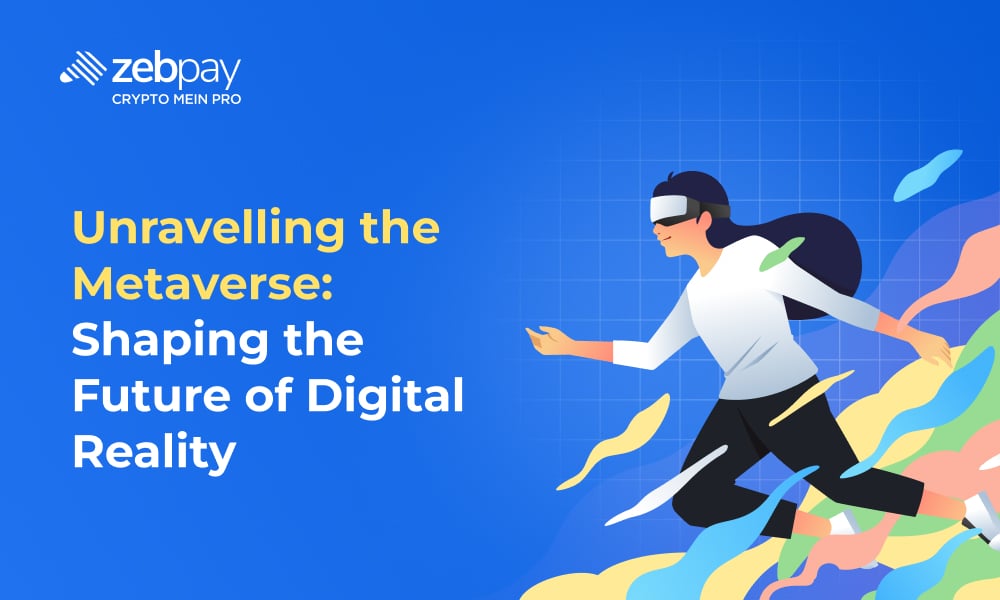‘Metaverse’ became one of those buzzwords we saw everywhere, for a while, and companies of all kinds couldn’t help but want to know more. Those with the resources did, and the engines of the wealthiest Silicon Valley corporations began moving. When a few of them got excited in the late spring of 2021, you could hear it echo across Twitter and in discussions about the tech bubble. Rest of them wanted to know the scope and scale of what their competitors were proposing, for them to get going. They desperately didn’t want to miss out on it, or the Fear Of Missing Out (FOMO), as Silicon Valley calls it. Talks around companies jumping on the metaverse bandwagon turned into announcements from the ‘Big Four’ to build out their metaverse empires. Industry experts believe that major tech companies have an important role in bringing the metaverse to life and establishing its culture. So, what exactly is the metaverse?
What is the Metaverse?
The metaverse is the next version of the Internet. It enables users to inhabit themselves in immersive three-dimensional spaces, in which they can interact with each other rather than in the physical world. They can explore, have meetings, and run into each other spontaneously, as in the physical world. The metaverse has long been under construction and, in fact, already exists as part of the shift to Web3, being the third version of the Internet, which has already begun to take shape.
In the early days of the modern Internet, referred to as Web1, the information on the web was largely static; with Web2, social media emerged alongside digital networks, forums, and crowdsourcing sites, transforming the Internet into a more interactive experience where users are active participants shaping it. With Web3, this experience will continue to be reinforced by creating a semantic or decentralised web. Anticipated to be called the metaverse, social networks are expected to evolve into fully immersive virtual worlds, each with its own economy, currency, and local cultures, resembling the interactions we experience in real life.
Major Players in the Metaverse Space
Let’s take a look at some of the major players shaping the metaverse space:
Meta
Meta leads the race to the metaverse. Formerly known as Facebook, this US tech company is a behemoth. Its products include the news feed, Facebook; Instagram, the photo-sharing service; Threads, for close friends and family; WhatsApp, the messaging service; the social media networking service, Facebook Messenger; a portal called Instant Games; among others, with more services being added. The company rebranded in 2021 to align with its interest in the metaverse. Since 2020, it has also invested $US10 billion ($15.8 billion) in virtual- and augmented reality (VR/AR) technologies for the metaverse. Meta’s Horizon Worlds platform enables users to build and tour spaces’ (akin to rooms and halls), virtually, while its Quest VR headsets allow ultimate immersion. Today, the company is hard at work on the anniversary of its inauguration in 2004—yes, its 20th anniversary—to innovate in AR and VR with Quest 3, in the hope of making the metaverse more accessible and engaging. Meta has a vision of involving the metaverse with fields such as education, medicine, and engineering.
Alphabet
Google’s parent Alphabet is the tech company behind Google Glass, Google Cardboard, and the Daydream VR headset. The firm is committed to further development of immersive experiences, where the users can experience personalised virtual worlds. Alphabet, recently, joined forces with Magic Leap, a leading AR startup, to develop experiences that meld the physical and digital realms with Google’s powerful AI and Magic Leap’s futuristic optics.
Microsoft
The company behind the metaverse might seem surprising, but since Bill Gates and Paul Allen founded Microsoft in 1975, the company has made its presence known, especially as an enterprise-oriented early-stage solution provider. Its Mesh product allows for mixed reality collaboration and meeting experiences, and it’s using this technology to enable a more natural form of interacting with digital content. In many ways, its blueprints for digital workforce metaverse solutions have become embedded in products such as Teams and Xbox. Microsoft, recently, acquired Activision Blizzard, giving it a powerful position in the world of games with access to iconic franchises to build immersive virtual worlds.
Apple
With its new Vision Pro headset, which combines elements of the VR of Oculus and the earlier AR goggles of companies, such as Google and Magic Leap, into a visually rich, spatial computing experience, Apple has also stepped into the metaverse. Built as a device for ‘spatial computing,’ the Vision Pro enters the market as part of Apple’s bold move against the current metaverse reality. Apple’s ‘blended-reality experience’ is a reimagining and refinement of the geospatial and distributed computing ethos of the metaverse pioneers.
Nvidia
Nvidia was founded in 1993, as a major force in computer graphics and AI technology, focused on unified computing and developing the tools that will create connected virtual worlds and other metaverse solutions using interconnected virtual universes. Its Omniverse platform enables artistically created 3D worlds, with GPU-accelerated performance to help artists create high-quality 3D content. Currently, Nvidia has more than 50,000 individual creators and 500 companies evaluating its Omniverse platform.
Epic Games
Epic Games, creator of the mega-hit video game Fortnite, is one of the major supporters of metaverse development. Its Unreal Engine suite of software tools provides powerful development environments for creating 3D virtual spaces. Last year, Epic hosted virtual concerts and other events with real-world celebrities on the Fortnite platform. Although Fortnite is a video game, the events reflected the promise of metaverse technology to support social experiences. Epic continues to push the boundaries in technology that blur the lines between games, social experiences, and virtual worlds.
Roblox
Started in 2004, Roblox, with tens of millions of daily users, is one of the biggest metaverse platforms. It emerged as a key player by deliberating on how to build a vibrant virtual economy that is fueled by a creator and user community, while engineering user-friendly software that helps users create their virtual worlds. Roblox’s engineering team developed software development kits and programs such as the Weld/Lua program (used to program Roblox objects) that are intuitive for virtual world creation. The platform also established a baked-in virtual economy where users pay, using its in-game currency called Robux, for virtual items and experiences that are built and sold by creators and artists.
Unity Technologies
Unity is a creator platform, providing a comprehensive set of software solutions to develop and operate real-time 3D content for the metaverse. Its Unity game engine supports the development of metaverse applications in various verticals, such as gaming, manufacturing, and architecture. It allows creators to build immersive spaces and engaging experiences, seamlessly, on different devices. Unity’s technology goes a long way in making, developing, and distributing metaverse content, making it accessible across multiple devices.
Strategic Partnerships and Alliances
In 2024, the metaverse is understood to offer multiple opportunities for businesses to promote their brands and interact with consumers, with major brands already investing in defining their presence and activities within the virtual space. Reportedly, fashion, automotive, tech, entertainment brands, among others, have started to create metaverse brand experiences, exclusive events, and even virtual stores.
Some fashion brands are already organising virtual fashion shows, where participants can interact with the digital collection by, for example, clicking, tapping, dragging, or hovering over garments and accessories, and making the purchase directly in the metaverse, while automotive companies are using virtual reality to let users explore, customise, and even go on virtual test drives of their latest car models. Tech companies are developing virtual showrooms, offering real-time product demonstrations and user interactions. In entertainment, leading brands are organising exclusive virtual concerts, movie experiences, and interactive activities that provide users with unique content and engagement.
These strategies not only boost brand visibility but also enable deeper connections with audiences, capitalising on the unique interactive nature of the metaverse. By participating in this ever-evolving digital landscape, brands can significantly influence users’ purchasing decisions and foster long-term relationships in their digital lives.
Challenges and Criticisms
As the metaverse evolves, a pressing question arises: Who Will Control this Virtual World? While no single entity is likely to own the entire metaverse, different platforms may be interconnected through agreed-upon protocols. Ownership may, instead, be viewed in terms of who buys virtual real estate and populates it with content. However, regulating the metaverse presents a challenge: Who Will Create and Enforce the Rules in this Digital Domain? This issue is especially urgent, given the ongoing tensions between big tech companies and governments over privacy, free speech, and online safety.
Data security is another significant concern, with questions being asked around how personal data will be used within the metaverse. Some fear that the metaverse could become another means for tech giants to harvest more data, potentially leading to misuse and market manipulation. The virtual world could foster an environment where data abuse and misinformation run rampant. Ensuring that security systems can protect users in this new landscape will be crucial, as current models may not be adequate to safeguard privacy and information within the metaverse.
A key issue with today’s metaverse experience is fragmentation. The ecosystem is often siloed, limiting what should be a fully immersive and interconnected experience. To build a cohesive virtual world, we must move towards making the metaverse a network of interoperable experiences. A true metaverse should be able to bridge these fragmented systems, creating a unified environment where all components, seamlessly, interact.
Future Outlook
Interoperability is set to be a cornerstone of the metaverse’s future, breaking down silos between different digital platforms and creating a seamless network of interconnected virtual worlds. This shift should allow users to protect their digital identities, preferences, and assets across multiple environments, enriching the overall experience. Efforts such as the Metaverse Standards Forum, expected to gain traction in 2024, showcase how diverse platforms are working together to build a unified and accessible metaverse.
This evolution in interoperability signals a significant transformation in how we interact with virtual spaces. Users will not be penned in by any platform. Integrated avatars and cryptographic keys will let you take your digital selves and stuff across metaverse ecosystems. This can usher in a more unified and expansive digital experience.
In 2024, an AI-first approach to creating the metaverse is anticipated to securely catapult its development and advancement, making the experience more creative, realistic, and responsive. The full gamut of AI modes will be enlisted to increase efficiencies in production and development, and second-by-second processing of information and data to alter or change experiences. In turn, this should also mean richer interactions on the public stage, with simulation-based action more seamlessly crafted and immersive, mirroring the repurposing of neurobiological activity in humans. The convergence of the metaverse with human reality should seem ever more accelerated, faster than real life. This comes as a natural consequence of AI advancements. More intelligent NPCs (non-player characters) should also help users feel a deeper sense of immersion.
Conclusion
Official reports suggest that tech titans will be instrumental in shaping metaverse’s future, as it will be in their technological ecosystems and toolkits, and with their resources and know-how, the metaverse will begin to be built in earnest and assume its final form. Metaverse pioneers are not only expected to be investing, internally, but are heavily innovating in these core technologies to make the metaverse real, immersive, and scalable across industries, from education to gaming to commerce. Amongst a wide number of global players, we can already identify some of the key tech players that are accelerating the potential of the metaverse: Meta—the newly named mother ship, renamed in honour and aspiration of this third Internet. Alphabet, Microsoft, Apple, and others are all increasingly betting on innovations in VR, AR, and AI to make the metaverse interoperable and immersive.
However, the power also brings the duty to enable ethical principles such as privacy, security, and inclusion. If innovation can be sorted, so can accountability; by forcing the two together, big tech can release the full potential of the metaverse in a fair and transparent digital space for its users.
In the grand scheme of things, ZebPay blogs is here to provide you with crypto wisdom. Click on the button below and discover endless features on ZebPay!




